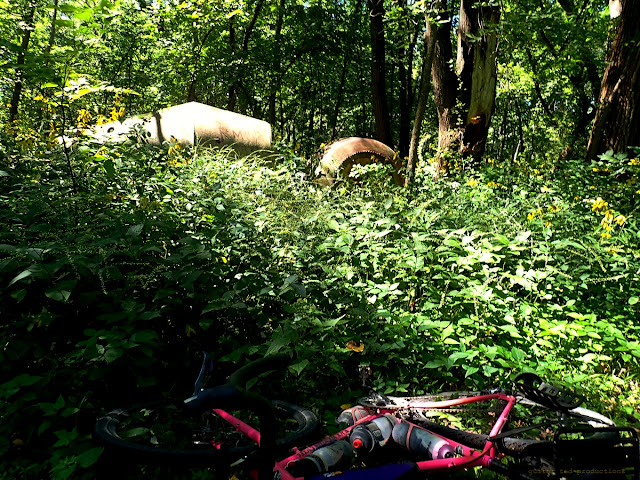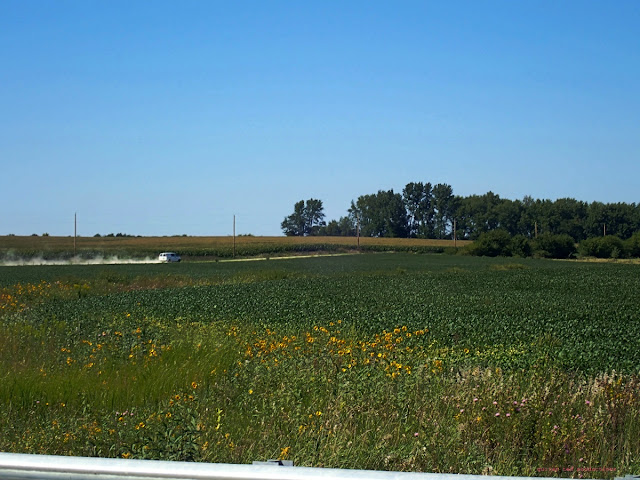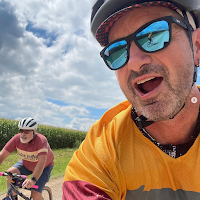 |
| Escape Route: Bike Path: University Avenue |
I was needing to test some tires, so that was part of the reason for the route I chose, but also, it is a good route when the winds are out of the Northwest. I go West mostly under the cover of woods and urban buildings, so there isn't much open headwind that way. Plus, it takes in part of my old commute to Andy's Bike Shop, which I miss riding.Then a lot of the North bit is sheltered as well, which is nice.
 |
| Along the Cedar River. The sunflowers are numerous and about 7-8 feet high this year! |
 |
| These abandoned mixer bodies remind us that at one time Lower Hartman Reserve was a sand and gravel quarry. |
I veered off to take in Shirey Way and a bit of twisty, turny single track through Lower Hartman reserve which I helped put in years ago. Hardly anyone knows that around here but me, but it is true. It used to be called "John's Trail" when it was new. I have no idea what the folks who came in afterward decided to name it.
 |
| North looking up Leversee Road. |
 | |
| Looking East down Bennington Road | |
After some urban street scrambling and bike path action North of Cedar Falls, I emerged on a blacktop road which took me to another, major County blacktop and I turned East out of the wind. Major relief! Then a mile north on what used to be gravel, but they ruined that and put down chip seal. Bah!
Eventually I got up North on Leversee Road to Bennington Road's Eastern side. I don't care who you are, East Bennington Road is one of the most beautiful sights looking East that I know of in Black Hawk County.
 |
| A SUV stirs up dust going North On Streeter Road |
 |
| The prairie sunflowers dominate the landscape this time of year. |
Going East was nice. However; the county maintainers have visited Bennington Road and the gravel was deep and thick. This made for some laborious riding, but I managed. At least the recent rains have settled the dust to a great extent and even though it was windy, I saw no evidence of the usual 'dust drifting' which you can often see on gravel when it is windy out there in the country.
 |
| A "Wooly-Bear" seen on Moline Road. This one says, "Bad Winter!" But..... |
 |
| ....this one seen less than five feet from the other seems to say "Huh? What Winter?" |
Wooly bears are out now. I learned from Dave Pryor when we rode together recently that the bigger the orange stripe, the better Winter is supposed to be. Well, I saw four Wooly Bears on this ride and two were completely black and two were completely orange.
Not sure what that means!
Fall is definitely working in now, whatever the Wooly-Bears might be trying to tell us. The Sun sets early now, and the corn is beginning to dry down. I was a bit saddened over the last week. There were so many things I wanted to accomplish over Summer that I never even got started on. Rides planned and not done. Time out in the country not taken. But maybe that's the "american" coming out in me. I am not what I have accomplished. That doesn't fulfill me.
I should be happy I got out at all. That I can ride is something I am privileged to be able to do both physically and from an economic standpoint. Some folks cannot do what I do at all for various reasons. That I didn't get to go nuts and ride until I passed out and then be upset about that is crazy. I need to learn to be satisfied with what I am, where I am, with what I have been given. That should be sufficient. It's more than I really need, to be honest.
I need to relax about my ambitions sometimes. Other times I waste time and that gets on my nerves too. But Life is a balancing act. We aren't always going to get that balance right. And that's okay.
I got a three hour ride in. I was satisfied and blessed.


















